Understanding and addressing Pitbull behavior problems is crucial for any responsible Pitbull owner. These intelligent and energetic dogs often display behaviors that, while natural to them, can be challenging for you to manage.
The common Pitbull behavior problems are:
- Aggression
- Excessive barking
- Destructive chewing
- Jumping up on people
- Pitbull puppy play biting/mouthing
- Separation anxiety
- Resource guarding
In this comprehensive guide, we delve into the common issues faced by Pitbull owners, from excessive barking and jumping to more complex issues like aggression and separation anxiety.
Our goal is to provide you with effective strategies and insights to help you nurture a well-behaved, happy Pitbull.
Join us as we explore the world of Pitbull behavior problems, debunk myths, and offer practical solutions to enhance your life with these remarkable dogs.
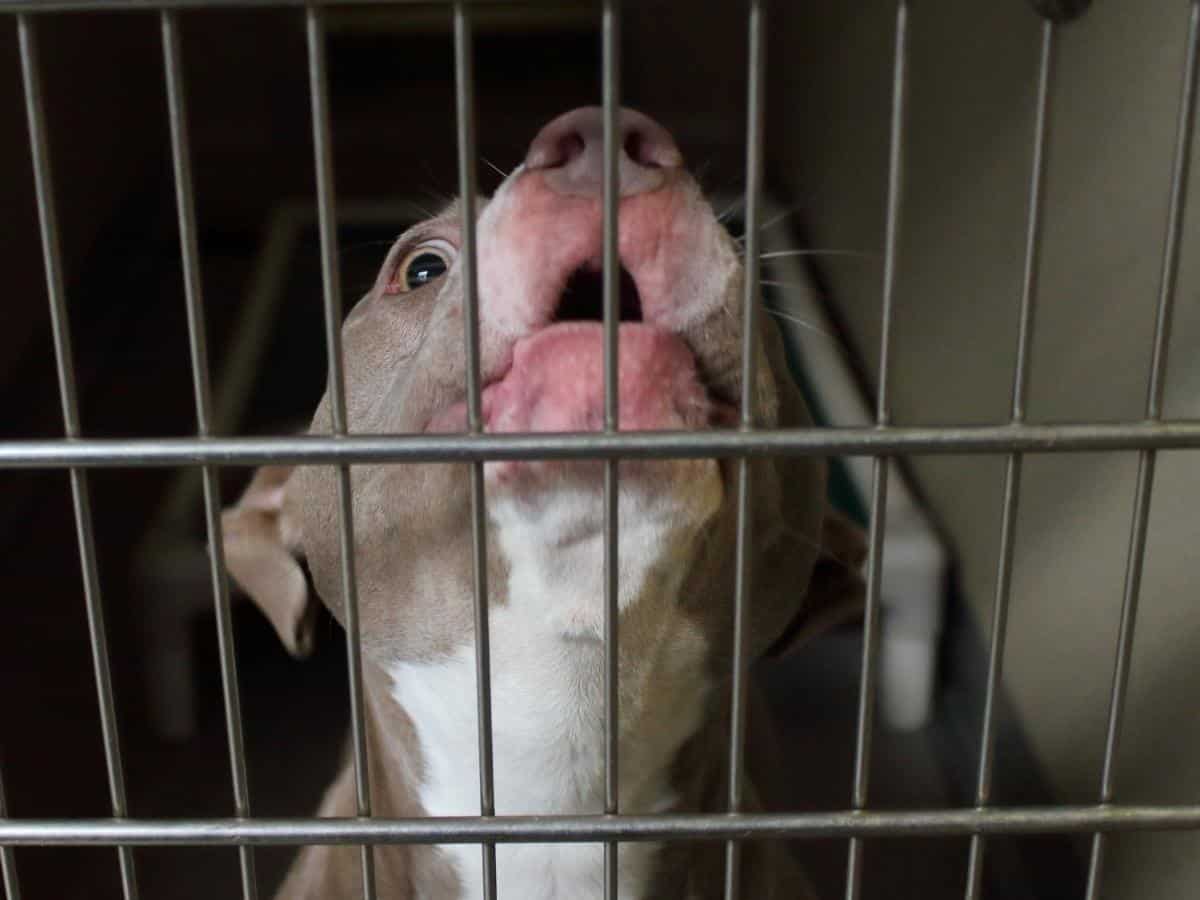
Common Pitbull Behavior Problems
Common Pitbull behavior problems include aggression, jumping up on people, excessive barking, puppy biting, and destructive chewing. Separation anxiety and resultant tantrums, alongside resource guarding, can also prove problematic.
However, the most common Pitbull behavior problems can be resolved with proper training, eliminating cues, and plenty of exercise – so if you’re having problems with your dog, don’t throw in the towel just yet!
Let’s look at Pitbulls’ most common behavior problems and discover how to fix them by changing the unwanted behavior. I’ll conclude this article by telling you what causes your Pitbull to misbehave in the first place.
1. Pitbull Aggression
Pitbulls can be very evidently aggressive. Do note that I didn’t say they can be very aggressive. It is their scale that makes their aggression more obvious. Unfortunately, their scale also makes their aggression more threatening to others.
If you’ve raised a Pitbull, you might get used to his baseline aggression levels. Only when you have company will you become uncomfortably aware of how imposing a Pitbull’s aggression can be.
We should remember that long before Pitbulls were socialized as household pets, they were bred for maximum fighting capacity and took part in the “sport” of dog fighting. Pair that with poor socialization leads to some Pitbulls acting on their aggressive instincts.
Media hype reinforces the stereotypes surrounding Pitbulls. However, multiple peer-reviewed scientific studies have concluded that a dog’s breed does not determine its risk.
For example, this study on the aggressive behavior of dogs affected by breed-specific legislation (such as Pitbulls) compared to other breeds (and where Golden Retrievers were used as a control group) found no substantial differences in aggression.
However, aggression in any dog breed can be unpredictable and dangerous. The information below applies to all breeds, not just Pitbulls.
Dog aggression will often manifest in a continuation of behaviors such as barking, growling, baring teeth, snapping, lunging, chasing, and biting. Pitbull aggression may be directed towards strangers, familiar persons, or other pets and animals.
Dog aggression can be classified into many categories, including:
- Fear – due to anxiety or insecurity
- Social – when a dog is unsocialized
- Protective – to protect family members
- Defensive – when danger is felt
- Territorial – to defend their space or hierarchy with owners
- Possessive – to protect possessions
- Predatory – may be breed-related
- Pain-induced – due to injury or illness
- Self-directed – when the dog harms himself
Your Pitbull may manifest one or more of these aggressions for various reasons.
Dog aggression is most often caused by owner-related issues, such as improper obedience training, too much pampering of your dog, aversive training methods, or not spending time with your pet.
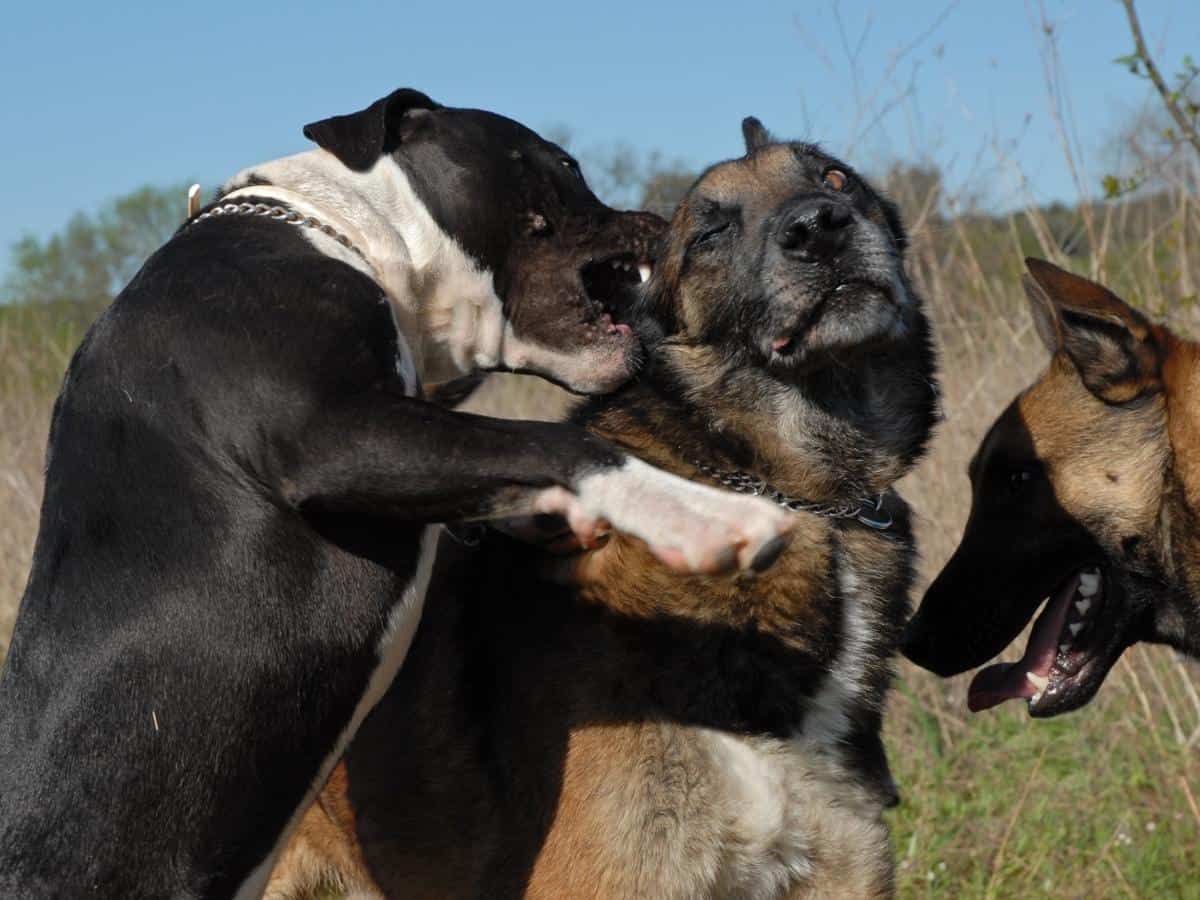
Breaking The Cycle of Aggression
The best solution for Pitbull aggression is to prevent it through proper socialization as a puppy. If you do not socialize your Pitbull when he is a puppy, you will have difficulty training him to be calm.
You can still socialize an older dog, but it will take a little longer, coupled with extra patience and discipline.
It’s vital to note that canine aggression is deemed both a training and a medical problem. Lack of proper training that leads to aggravated aggressive behavior necessitates veterinary and professional attention.
You must take a preventive approach when dog aggression is a training issue. This includes teaching your puppy bite inhibition, not to jump up at people, and not to snarl when their things are touched. All this should be initiated early on.
As a medical issue, your Pitbull will exhibit consistent aggression symptoms, especially around 8-12 months of age, even though you have trained him right.
In this case, you should seek medical advice and treatment from a vet or procure a dog behaviorist’s professional intervention.
Dogs acting aggressively toward people they know need stringent behavior modification therapy and sometimes medication.
Watch How To Prevent Your Pittie From Being Aggressive In This Video…
2. Excessive Barking in Pitbulls
Pitbulls don’t bark often, but when they do, they are loud! If you have young kids in the house, this can scare them easily.
For better or worse, no solution exists to “fix” a Pitbull’s bark. And that’s because barking is just a symptom of an underlying problem.
Pitbulls may bark at other dogs due to insufficient socialization, fear, or anxiety. Other causes are poor training, being protective or territorial of family, or generally being social or excited and wanting to greet or play, especially if under-exercised or under-stimulated.
Here are some examples in which a healthy Pitbull barks to excess:
- During a thunderstorm – You can desensitize and counter-condition your Pitbull and get him to be a little calmer when there is thunder. You can also consider anti-anxiety medication or supplements that help dogs stay anxiety-free during heavy rain and thunderstorms, but consult your vet first.
- When he is protecting his human parent – You will need your Pitbull to defend you in rare cases. Pitbulls are protective by nature. Generally, he will think he is protecting you when the “threat” is only the local delivery guy. Try to pre-empt the delivery guy’s arrival and offer your Pittie a tasty treat or favorite toy.
- When he is anxious – This type of barking is persistent and seems to happen without significant external stimulus like an uninvited guest. Helping your dog reduce his anxiety is a lengthy process that involves building trust.
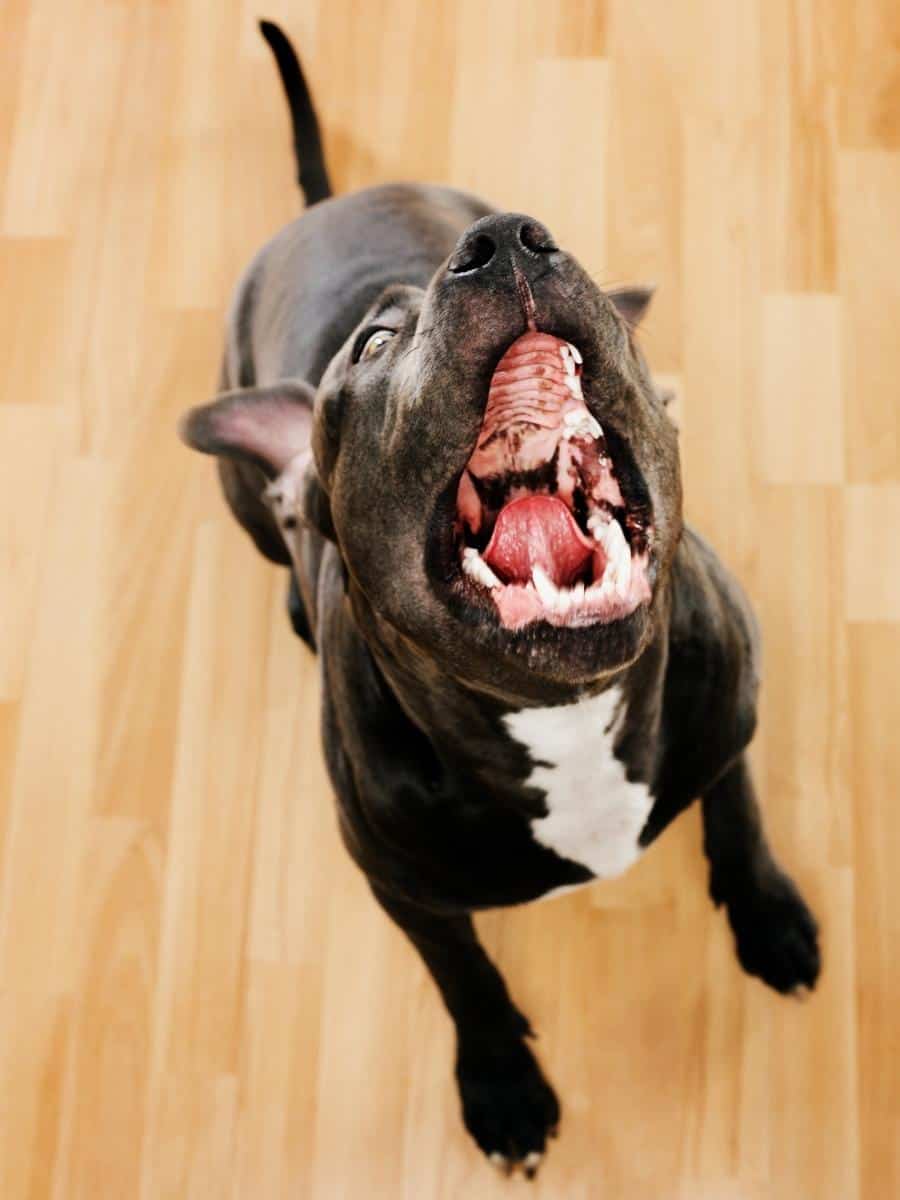
Turning Down the Volume: How to Manage Your Pitbull’s Barking
The less anxious your Pitbull, the less often he will bark to excess. You should start with socialization and get your Pitbull accustomed to the presence of other humans and dogs.
If he has a barking habit contingent on people’s presence, you must desensitize and counter-condition him from the stimulus.
Desensitization involves repeated and progressive exposure to the stimulus that provokes the barking.
Counterconditioning involves pairing this stimulus with something positive (e.g., treats or toys) to change the emotional response, i.e., excessive barking.
Both of these techniques go hand in hand. You start with limited exposure when counterconditioning a poor habit with a good one.
In this example, you’ll have a friend stand quite far back but not too far to be seen. You should distract your dog and treat him when you notice him. In this case, the dog doesn’t bark because your friend is distant. But you still reward him for not barking.
You need to patiently repeat this while bringing your friend closer. He has to come as close as he can before your Pitbull starts growling. That’s where he should step back. This ensures that your dog doesn’t start barking. Instead, he becomes calm again.
As soon as he is calm, you reward him with a treat. After a while, he will notice that seeing people means rewards and will be happy to see them. You can do the same thing with thunder sounds on YouTube and the volume button.
3. Destructive Chewing
Pitbulls can bite through pillows, chew out furniture posts, and tear up your wallpaper. Puppies tend to chew things when teething as they have to cope with the discomfort of sore gums.
The pain of teething will cause your Pittie pup to bite on you, your table leg, or other surfaces to find relief.
But their chewing becomes more intentional and destructive when it becomes an out for boredom or as an avenue to relieve anxiety.
Destructive chewing on things that you value, such as your couch, shoes, books, and other household objects, can be caused by:
- Poor obedience training
- Loneliness from being left
- Lack of physical and mental exercise
- Excessive stress in the home
- Obsessive-compulsive behavior
Tackling Destructive Chewing
It might seem like introducing a chew toy should solve the problem of puppy biting. There are also chew toys that can double as treat dispensers for dogs.
The best approach is teaching your Pitbull puppy not to bite on your shoes, couch, or table – but instead, provide a range of chew toys.
Consider these two from Amazon for Pitbull puppies:
- KONG Puppy Toy is made from soft rubber intended for a growing puppy’s teeth and gums but is tough enough to defy a puppy’s natural desire to chew. This toy is also multi-functional and can be used as a fetch toy or as a treat-dispensing toy, which you can stuff with treats or peanut butter.
- Bojafa Puzzle Teething Balls are durable, puncture resistant, and made from Non-Toxic rubber material, yet soft enough to chew. I love these balls as they soothe your pups’ gums, help clean teeth, and satisfy their innate desire to chew. They also double as puzzle toys that you can stuff with yummy snacks.
Note: Clicking the above link(s) will take you to Amazon or an online store where we have an affiliate relationship. If you make a purchase, we may earn a commission at no additional cost to you.
But if your Pitbull chews his way due to stress and anxiety and you give him a toy that rewards him for chewing, good luck to everything in your house that’s softer than a canine tooth!
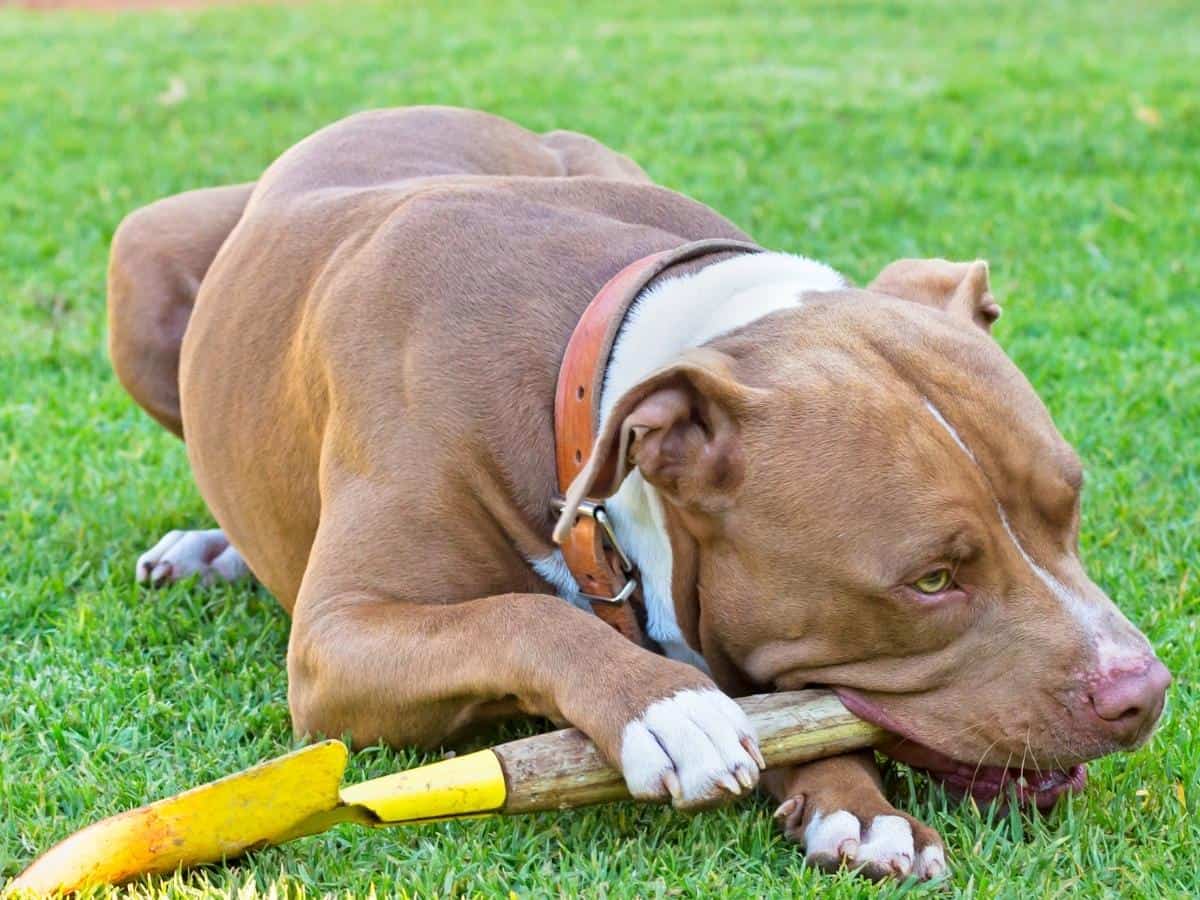
As with the causes, the solutions for excessive chewing in an adult Pitbull can be diverse. These will include:
- Retrain your Pittie. You may need to retrain your dog if you think obedience training was poorly done or incomplete during puppyhood. Consider the help of a professional trainer for an expert assessment.
- Give your dog a bone to chew. A raw beef shank bone larger than your dog’s muzzle is ideal as it won’t splinter and cause injuries or choking. Always supervise your Pittie when giving him a bone.
- Provide ice cubes or frozen treats. These help your dog to find relief from sore and painful gums. You can offer frozen strawberries or raspberries as a healthy alternative to store-bought treats.
- Lots of exercise. Ensure your Pitbull has the advised 1-2 hours of exercise daily consisting of morning and evening walks and/or running and playtimes such as frisbee or fetch.
- Consider health issues. If you believe your dog’s chewing is more than bad behavior and have exhausted all other remedies, consult your vet to rule out medical problems such as stress, OCD, or malnutrition.
4. Jumping Up On People
When a Pitbull jumps up on someone out of excitement, you can see the individual having pre-death flashbacks because of their reputation – especially if they’re not a dog lover.
However, Pitbulls jump up for many reasons:
- They want attention
- They’re excited
- Displaying dominance
- They want to greet you
- Poor socialization
It is a natural instinct for dogs to want to jump up. Puppies jump up on their mother to feed or greet her. Dogs greet each other face to face and sniff each other, so when they greet a human, they want to jump up to reach their face and say “hello.”
Often, a Pitbull jumping up on people doesn’t have any severe consequences. Still, you need to discipline your Pitbull to avoid jumping up, as it can be unsettling and annoying for your guests.
Keeping Four Paws on the Floor: How to Stop Your Pitbull’s Jumping
To stop your Pitbull from jumping up on people, follow my 3 tips below:
- Ignore your dog when he jumps up. Your Pitbull will soon learn that he doesn’t get love and attention if you ignore him, so keep greetings low-key. You should also tell your visitors to ignore your dog when they arrive.
- Train a different greeting behavior. Teach your Pitbull an alternative behavior. For example, command him to sit or lie down.
- Use positive reinforcement. Reward your dog with treats when he performs the desired behavior you are teaching him. Never use aversive training methods such as physical punishment or yelling, as this will only make your Pittie aggressive and resent you.
5. Pitbull Puppy Play Biting / Mouthing
Playful mouthing, nipping, or biting by your Pitbull puppy can be cute. But after experiencing it for the first few days of bringing your new puppy home, you’ll want to control this behavior, especially as your Pittie’s teeth become razor sharp – and his jaws become stronger!
Due to its ancestry and genetics, a pitbull will mouth and playbite. A descendant of the original English bull-baiting dog bred to bite and hold bulls around the face and head, it naturally wants to put things in its mouth.
When bull-baiting was banned in the 1800s, people began to fight their dogs against each other. Pitbull mouthing and play biting are not aggressive – there is a distinct difference between typical play biting and aggressive behavior.
Training Your Pitbull Puppy Not to Bite
To prevent innate mouthing and play biting from becoming an aggression problem, you should adopt an immediate preventive training approach by teaching him his bite inhibition.
You should initiate bite inhibition as soon as you bring your puppy home. All puppies discover their “soft mouth” during playtime with their siblings, which is a vital part of socialization.
They soon learn that the fun stops if they bite their littermates too hard!
A dam teaches good canine manners and disciplines her puppies when they misbehave or bite too hard. Removing puppies too soon from their mother can determine the dog’s future behavior, As detailed in this study.
Your Pitbull needs to continue to learn his bite inhibition so that he’s always gentle, even when playing.
When teaching your Pitbull puppy bite inhibition, make a sharp cry every time he bites or nips at your skin until he releases his hold. Immediately redirect the behavior by giving him an exciting chew toy, rewarding him with a treat, and giving lots of verbal praise.
Continue doing this until your puppy either stops biting or develops painless biting. This is known as “soft mouth.” You’ll know you’re on the right path when you first notice your Pitbull licking your hand instead of biting.
Learn How To Stop Pitbull Puppy Biting In This Video…
6. Separation Anxiety
Dogs, in general, form a deep bond with their guardians. But protective breeds such as the Pitbull form even stronger bonds, which can result in separation anxiety when left alone.
When you go to work every morning, your Pitbull might assume he is abandoned. The more excited your dog is to see you upon your return, the more likely he will be anxious in your absence.
In this state of anxiety and assumed abandonment, your Pitbull might lash out at your furniture and engage in excessive barking or other destructive behavior.
You need to exercise empathy and understand that separation anxiety is a medical condition.
Just like you wouldn’t force a Pitbull with a broken limb to play fetch, you shouldn’t force a Pitbull with separation anxiety to stay and wait for you without any connection for an extended period.
Alone But at Ease: Preventing Separation Anxiety
Working out why your Pitbull reacts severely to being left alone can be challenging. But there are some things you can do to relieve your dog’s distress when he’s alone.
To stop separation anxiety in your Pitbull, keep departures and arrivals low-key and leave your dog in a relaxing and comfortable place. Here are some other ways to prevent separation anxiety in your Pitbull:
- Don’t leave your Pitbull alone for too long. You should never leave your dog alone for longer than four hours, even less for young puppies.
- Keep your dog occupied while you’re away. Ensure you leave your dog’s favorite toys out. Check out the Outward Hound Dog Brick Puzzle Toy. This toy will keep your dog entertained and is great fun, especially when he finds the treats!
- Consider alternatives. Minimize your Pitbull’s time at home alone by hiring a dog sitter, walker, or professional trainer. Have friends and family call around, use doggie daycare, and work from home if possible.
- Stay connected with your dog. It’s easy to stay hooked up to your Pittie using cameras such as the Furbo Dog Camera. I like this one as you can even toss him a treat as you follow your dog’s activity using the live stream video.
- Use behavior modification training. Countercondition your dog by teaching him not to associate departure cues (e.g., your keys jangling) with you leaving. The goal is to train him not to worry about your exit by getting him used to the sound of your keys with getting a treat.
- Use desensitization techniques. Teach your dog to cope with being alone by carefully exposing him to being alone in small steps. E.g., start by making progressive departures of 2-5 minutes and gradually increase. Train your dog to be alone from a young pup. I left my dog in her crate for a few minutes at a time at 8 weeks old to prevent anxiety.
- Treat with medication. Both anti-anxiety medicine and natural supplements can help treat separation anxiety in dogs. Your vet can advise you of the best treatment plan for your dog if all other techniques have failed.
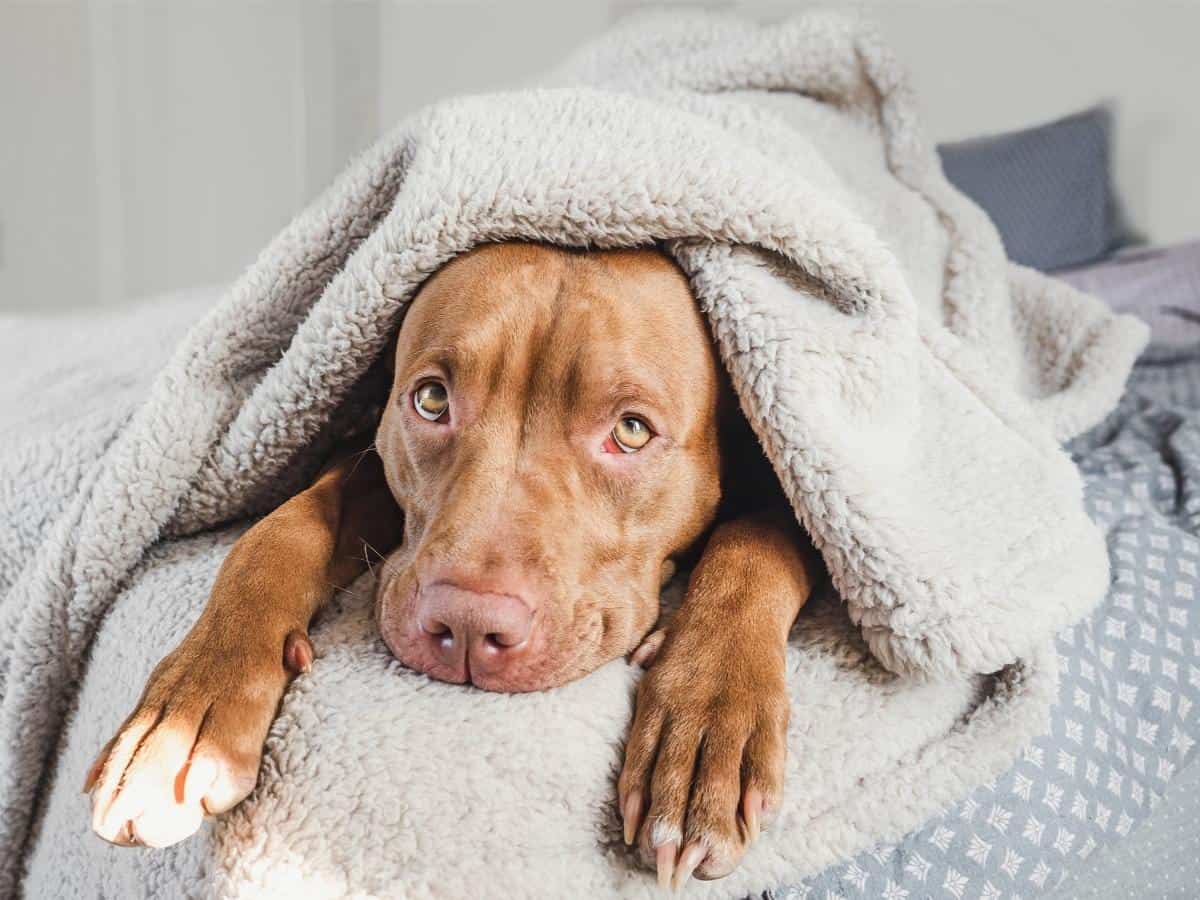
7. Resource Guarding
While fear is the primary reason Pitbulls bite, sometimes they can develop a behavior known as “possessive aggression.”
It usually happens when you get into an area claimed by a territorial Pitbull or access a resource he is actively guarding, which he truly values.
Canine resource guarding sounds good but is terrible behavior in reality.
When a Pitbull starts seeing his food, bed, or favorite toy as something he has to protect from you, he positions you as “the other.” Earning your Pitbull’s trust is crucial to stopping this.
No More Growls: Teaching Your Pitbull to Share
Early and continuous training can help prevent resource guarding before it becomes a significant behavior problem. It is better to prevent it by not letting your Pitbull’s feeding routine or toy choices stagnate.
Switch up the following on a semi-regular basis to discourage resource-guarding:
- Food bowl (size or shape) – Dogs aren’t great at noticing color, so when you switch your Pitbull’s bowl, don’t just get the same bowl in a different color. Get a bowl with a noticeably different shape or size. Your Pitbull should know that his food is not connected to the bowl but to you.
- Location of the bowl – Dogs don’t process things with the same logic as we do. They notice simultaneous conditions and come to their conclusions. That’s why dog commands work. They don’t know that “SIT” means sit. They just know that the sound relates to them sitting because it is uttered when they are sitting.
When similar reasoning is applied to feeding, your Pitbull might assume that because he gets food in a specific corner every time, the corner is integral to his sustenance. By switching up the location of his bowl, you solidify that the location doesn’t matter and the only constant in his feeding routine is you as the provider.
- Toys – Pitbulls can get bored, and since toys are their escape from boredom, they can get pretty easily attached to their favorite toy. Rotating your dog’s toys shows him that you allow him to play with them and that they aren’t his property. That might sound harsh, but helping your Pitbull see this is good for him in the long run.
- Location of the dog bed – finally, dogs sleep where they feel protected. And if your Pitbull is sleeping in the same corner every night, he might get territorial. Resource guarding isn’t just about food and water. Sometimes, the “resource” your dog is guarding is real estate. By changing the location of your Pitbull’s bed now and then, you get him to feel safe in different parts of the house. More importantly, you make him less territorial, which is great for his social life.
Here are some further steps to stop your Pitbull from resource guarding:
- Use desensitization and counterconditioning techniques.
- Don’t leave items lying around that your dog becomes possessive over.
- Don’t punish growling behavior.
- Teach your dog essential training commands such as “LEAVE IT” or “COME.”
- Consult a certified trainer or dog behaviorist.
Watch How To Prevent Food Aggression In Your Pitbull…
Reasons for Pitbull Behavior Problems
Pitbulls have innate behavior dispositions unique to the breed, like all other dogs. Think of their instinctual over-protectiveness towards their owners and how that can cause them to be aggressive towards strangers.
But Pitbulls grow to be the dog you train them to be. And if that is not done correctly, behavior problems will arise. However, that is not the only reason why your Pittie may be misbehaving.
Pitbulls have behavior problems due to poor socialization and training, letting your dog have his own way, insufficient exercise, hormones, health reasons, and the use of aversive training methods.
Genetics can also cause poor behavior, which is easily solved by training.
Anxiety, fear, and an abundance of energy (manifested as aggression) are the key contributors to all of the behavioral problems of new Pitbulls.
Rescue Pitbulls can have undiscovered triggers that can make them act a certain way. But even those are linked to feeling unsafe or threatened.
Genetic Disposition to Bad Behavior
It has been scientifically proven that dog behavior has both genetic and environmental causes.
In simple terms, your Pitbull may inherit genes predisposing them to aggression from their parents, which does not mean that you cannot tame the behavior through training.
This is one of the reasons why it’s always wise to meet the parents of your prospective Pitbull puppy. Or, if you are getting a rescue, see if the shelter has any information on the parents.
New research also identified that dog behavior often isn’t attributed to breed, which backs up my other points mentioned in the “aggression” section.
This study challenging popular breed stereotypes found that most traits weren’t linked to any specific breed. While some behaviors could be linked to genetics, others were likely due to environmental influences.
Read more: Are Pitbulls Bad? 7 Reasons NOT to Get a Pitbull
Poor Puppy Socialization
Poorly socialized puppies grow into badly behaved adult Pitbulls. Science has determined that between 3 and 12 weeks is the most important in a puppy’s socialization process.
This period includes the start of play between littermates, following each other, and running in groups. If a Pitbull is not socialized well at this age, he will become an unapproachable and untrainable adult.
Proper socialization training means exposing dogs to different environments where they learn how to interact positively with other people and animals.
This makes them more calm and confident instead of being anxious and aggressive, traits found in unsocialized and badly trained dogs.
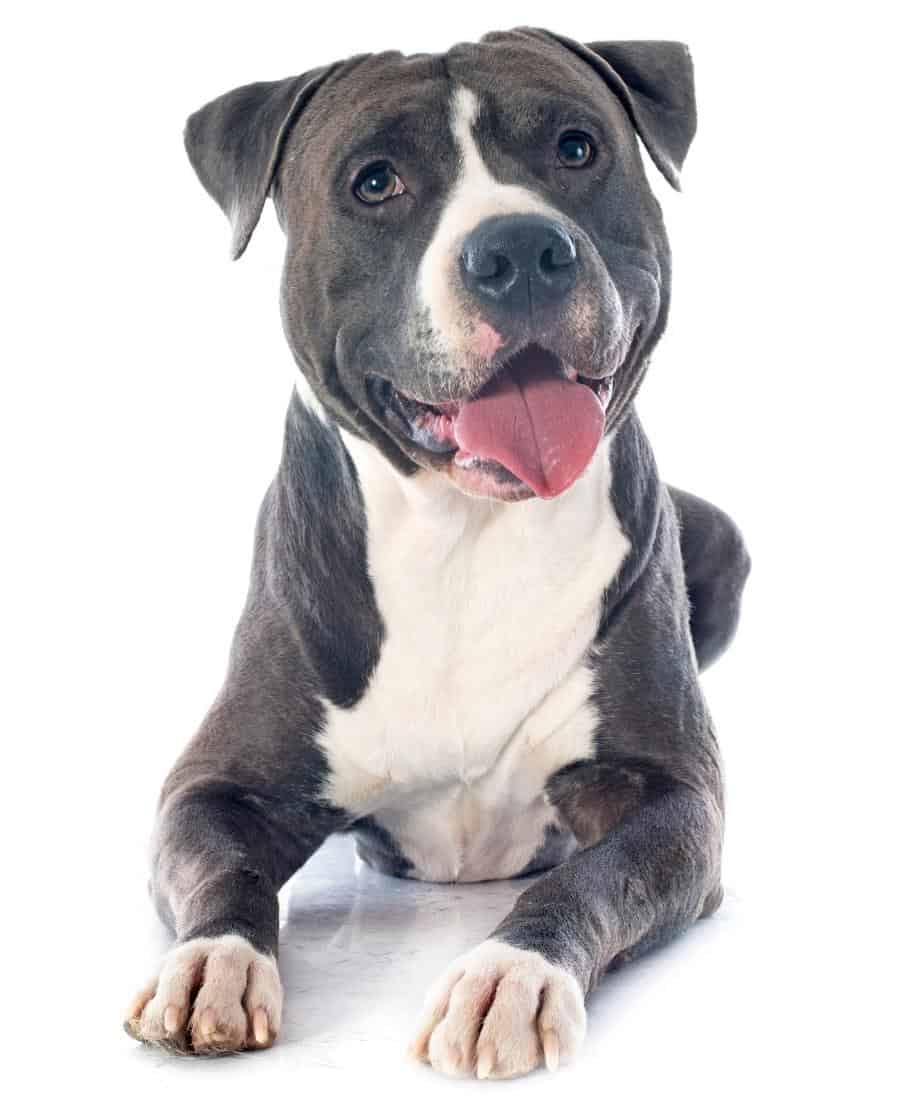
Incomplete Obedience Training
Obedience training is vital in helping your Pitbull understand your expectations. Many new dog owners believe a week or two of training after bringing their dog home is enough. Not so!
You’ll need to show consistent training for months to help your dog learn all the basic and advanced commands he needs to be well-behaved.
Leaving training half done means your Pittie has not mastered the commands, and you’ll have to keep starting over.
Consistency also refers to employing the same terminology to seek a specific behavior from your Pitbull. Otherwise, you’ll confuse your doggo and think he’s disobedient when, in reality, he’s confused.
Aversive Training Techniques
Punishing your Pitbull in an attempt to teach him good behavior will have the opposite effect. Positive reinforcement training has been shown to bring out the best behavior in dogs since you encourage it by frequently rewarding your pet.
Instead, as highlighted in this study, aversive training methods may be less effective in teaching good behavior as dogs experienced poorer welfare during training sessions than dogs trained with reward-based methods.
Gonadectomy and Hormonal Effects
Testosterone is often associated with aggression in male dogs. Gonadectomy is the generic term for the surgical removal of the male testes or female ovaries.
Many people believe that neutered/spayed dogs are less aggressive. However, research results from a substantial sample of nearly 14,000 dogs show that this is not wholly the case.
This fascinating study showed no significant increase in aggression in neutered dogs EXCEPT those neutered/spayed between 7 and 12 months of age. Scientists still cannot explain this.
Additionally, this study found that other hormones could be the rudimentary cause of canine aggression.
Oxytocin (OT), a hormone associated with sexual reproduction and social bonding, and Vasopressin (AVP), which controls the amount of extracellular fluid volume and renal handling of water, can negatively impact dog behavior.
The basic conclusion is that your Pitbull’s behavior issues may be caused by hormonal dynamics.
Letting Your Pitbull Be The Boss
What if you heard a Pitbull owner say their dog never misbehaves, only to discover that the owner lets the dog have his own way? Would you call that a well-behaved dog?
Failing to set boundaries with your Pittie can be another reason he has behavior issues. Your dog can poop on your newly purchased rug, and you’ll still feel pity for him (“Poor thing, he just couldn’t hold it!”).
Such a dog will show aggression as soon as someone tries to set boundaries, such as at the vet or at the dog park. Research has shown that “spoiling your dog” is one of the main factors that cause dominance aggression in dogs.
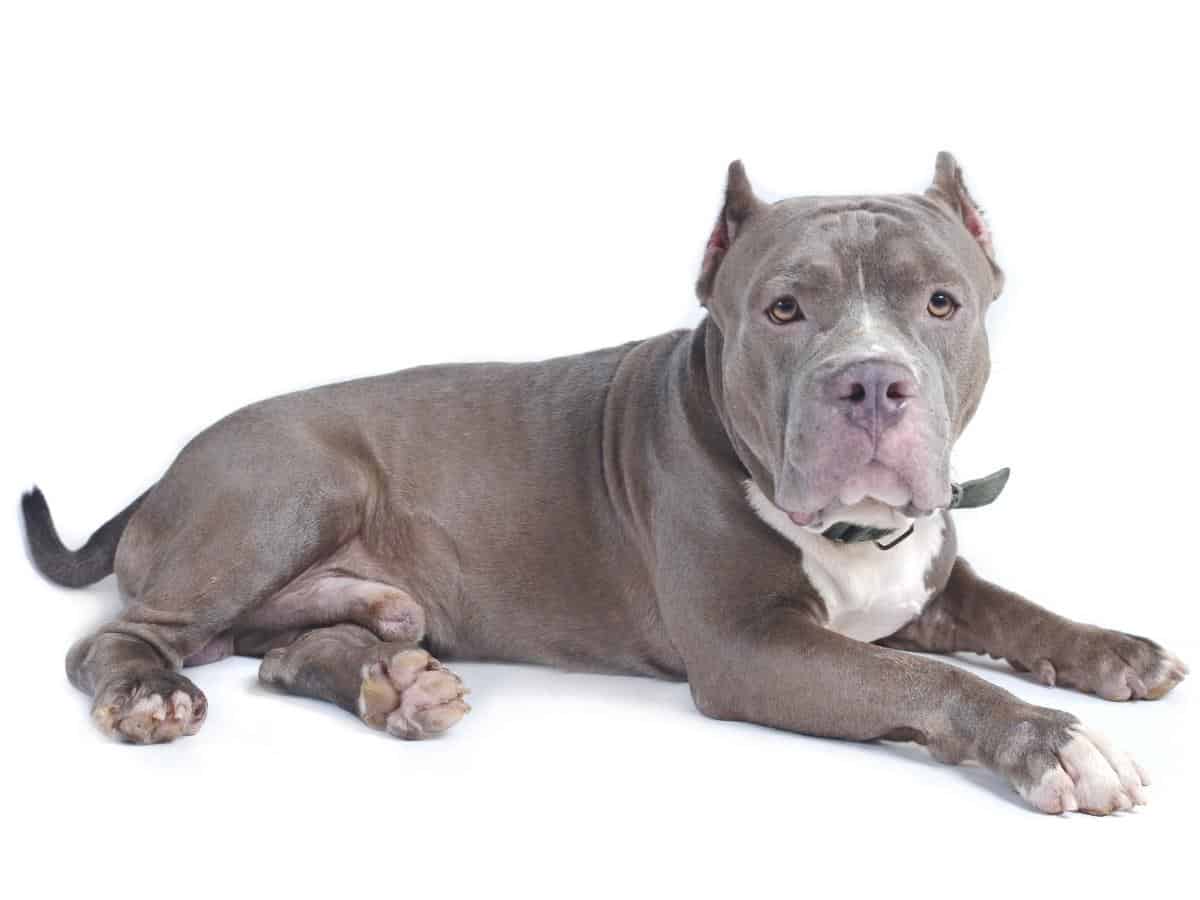
Insufficient Exercise
The Pitbull is a high-energy dog requiring at least 1-2 hours of daily exercise, and I mean more than just leash walks! In addition to walking, he will need lots of interactive play, fun games, and mental stimulation.
If you try to turn your Pittie into a lap dog, he’s sure to have behavior issues, which will manifest mostly in destructive behavior.
Less active dogs will exhibit behavior problems when compared to their well-exercised counterparts. For example, this study revealed that dogs involved in physical activity are less likely to show aggressive temperaments than those living a more sedentary life.
Medical Conditions
Your Pitbull may show behavior problems due to illness or medical conditions. These could be physical and psychological.
For example, dogs with obsessive-compulsive behavior are commonly linked with self-directed aggression and self-mutilation, particularly through biting.
A study on clinical features in dogs with OCB indicated self-mutilation as the most recurrent of these features.
Other medical conditions that may cause behavior issues in dogs include injury and post-operative pain, which can trigger aggressive behavior.
Final Thoughts
Most Pitbull behavior problems stem from inadequate socialization, training, and exercise, though genetics and health issues can also play a role.
A well-cared-for Pitbull, feeling safe and understood, can be more manageable than you might expect. However, if they feel threatened or anxious, behavioral issues may arise.
Thankfully, these behavior issues can be managed. Regular exercise, consistent training, addressing specific triggers, and possibly consulting a canine behaviorist are effective strategies.





